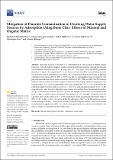Mitigation of Fluoride Contamination in Drinking Water Supply Sources by Adsorption Using Bone Char: Effects of Mineral and Organic Matrix

View/
Date
2024-10-20Author
Ibrahim, Mohamed
Oyetade, Joshua
Dalhatou, Sadou
Nikiforov, Anton
Leys, Christophe
Hilonga, Askwar
Metadata
Show full item recordAbstract
This study focused on fluoride (F−) contamination of water sources in Bahimi village, Cameroon. After the first investigation, results revealed that all water samples collected had elevated concentrations of fluoride ions (2.3 ± 0.1) mg/L to (4.5 ± 0.2) mg/L above the WHO guidelines (less than 1.5 mg/L). To mitigate the F− levels, the use of bone char (BC) as an adsorbent material was proposed and its performance was tested. BC was prepared from bovine bones at different calcination temperatures (350 °C, 450 °C, 550 °C and 650 °C) and residence times (1 h and 2 h). The prepared materials were characterized in detail by SEM/EDS, BET, FTIR, and XRD. The BET findings indicated that the surface area of BC samples decreased with increasing calcination temperature and residence time. At a lower heating temperature and holding time (350 °C, 1 h), the prepared BC exhibited a higher specific surface area (112.3 ± 0.3) m2/g and adsorption capacity for F− in the sampled water. Also, the batch adsorption experiments showed that the optimized adsorbent dose of 8 g/L facilitates the reduction in the F− level of the sampled water below the acceptable limit level (1.5 mg/L) within 5 min of treatment. The presence of Ca2+ and Mg2+ in natural water has a positive effect on the removal of F− in BC resulting in a high adsorption performance range of (72.5 ± 1.4)% to (80.3 ± 0.6)%. It was found that the adsorption of Ca2+ on the BC surface occurs via cation exchange with Na+. However, an increase in dissolved organic carbon (DOC) in the treated water limited the application of BC. Overall, the study presented a cost-effective adsorbent for the removal of this recalcitrant ion in the water source.
